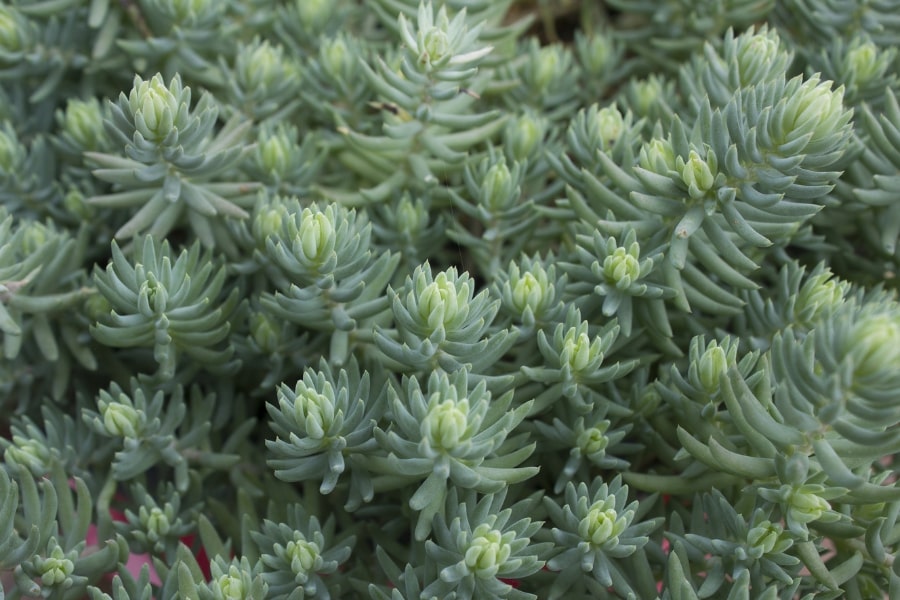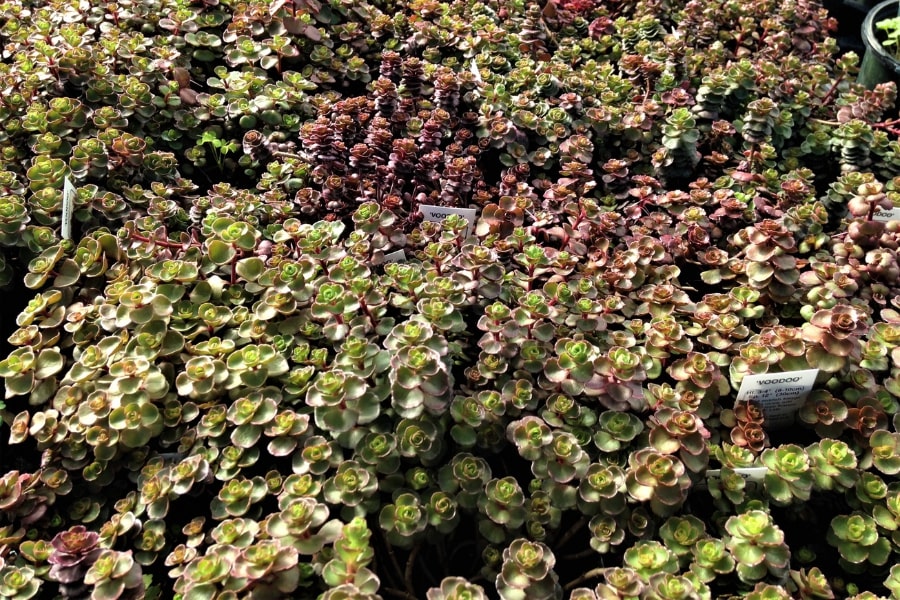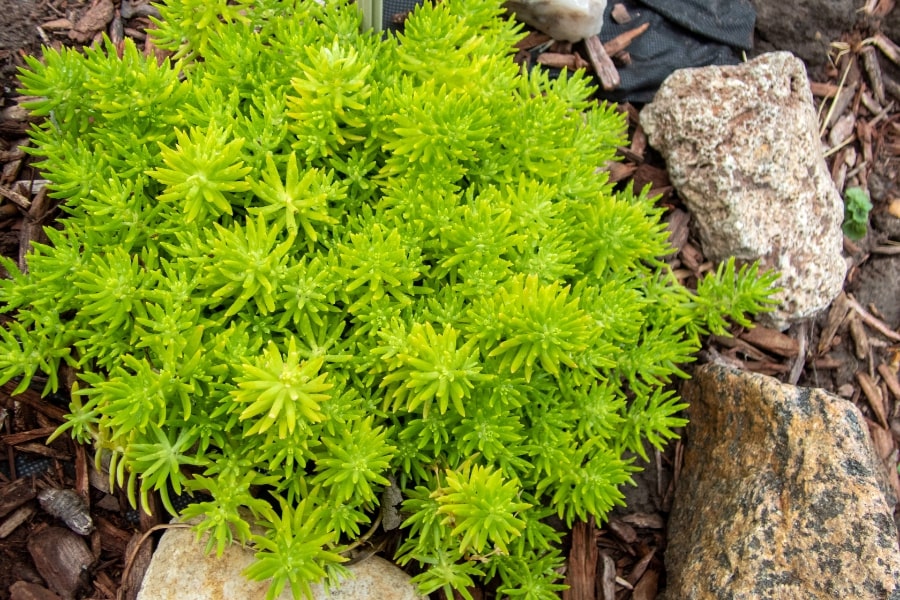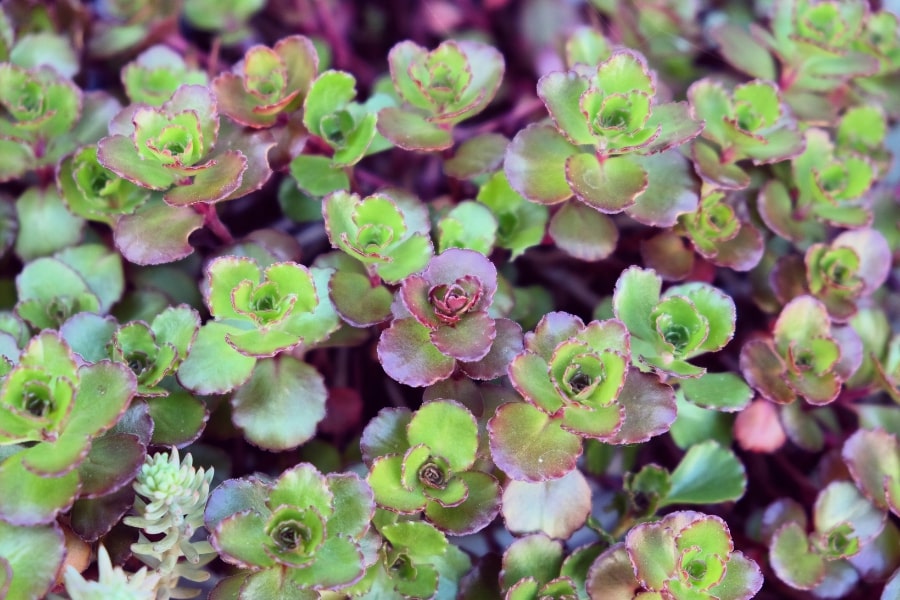Sedum is a diverse and resilient genus that belongs to the Crassulaceae family, often called the stonecrop or succulent family. While some Sedum species are native to North America, others are native to Europe, Asia, and even Africa. Sedum is known for its unique foliage, vibrant flowers, and adaptability to various growing conditions.

Our Selection of Sedum
At Martin Garden Center, we both grow and import numerous types of Sedum. Some of the low-growing varieties include the evergreen and ever-popular Sedum Lemon Ball, which is the single biggest selling perennial at Martin Garden Center. We try to keep Lemon Ball Sedum evergreens stocked in 4″ containers all year round. The less popular, but still evergreen, Angelina Sedum is also stocked nearly all year round in 4″ containers.
We are growing the following varieties in 2025:
We also receive Sedum from our regional vendors. Common varieties include Coral Reef, Larinem Park, Ogon, and Tri-color.
Growing and Caring For Sedum
Most Sedum varieties thrive in well-draining soil, as excessive moisture can lead to root rot. These succulents prefer full sun to light shade, making them ideal candidates for sunny garden spots, rock gardens, and containers. Sedums are remarkably drought-tolerant once established, thanks to their water-storing leaves.
When it comes to care, regular watering is essential during the establishment period, but once the plants have taken root, they can withstand periods of dryness. A balanced fertilizer should be applied during the growing season to promote healthy growth and flowering. Pruning or pinching back Sedums in spring can help maintain their shape and encourage branching. Stonecrop is generally resistant to most pests and diseases and tends to be deer resistant.

Leaves and Flowers
One of the most striking features of Sedums is their distinct leaves, which come in an assortment of shapes, sizes, and colors. These leaves often store water, enabling Sedums to thrive in arid and challenging environments. Depending on the variety, Sedum leaves can range from rounded to elongated, and they may be smooth, waxy, or even slightly furry. The leaves hues can span the spectrum, including shades of green, blue-green, red, purple, and even variegated patterns.
Sedums are also known for their flower clusters, known as inflorescences. They vary in size and shape but are typically composed of numerous small, star-shaped blooms. These flowers come in shades of white, yellow, pink, and red. Sedum’s flowers often bloom in late summer and early fall, adding a burst of color to the garden during a season when many other plants are winding down.

Uses in the Garden
Sedum is a highly versatile and low-maintenance plant that thrives in a variety of garden settings. Its drought tolerance and ability to grow in poor, rocky soils make it an excellent choice for rock gardens, xeriscapes, and dry borders where other plants may struggle. Taller varieties, like Autumn Joy, provide late-season color and structure in perennial beds, while low-growing types, such as Sedum ‘Angelina’ or ‘Dragon’s Blood,’ work beautifully as ground cover, spilling over walls or softening the edges of pathways. The thick, succulent foliage of Sedum adds interesting texture to the garden, while its clusters of star-shaped flowers provide a long-lasting burst of color.
Beyond its aesthetic appeal, Sedum also pairs well with Ornamental Grasses, Echinacea, and Rudbeckia, creating dynamic, drought-tolerant plant combinations that require little upkeep. Sedum’s ability to thrive in containers makes it a great option for patio gardens, where its trailing or mounding forms can add interest to mixed plantings. Because it is both deer and rabbit resistant, Sedum is ideal for gardens in areas where browsing wildlife is a concern.

Frequently Asked Questions
Do Deer Eat Sedum?
With its succulent leaves and stoic stature, sedum often evades the hungry appetites of these gentle creatures. Its texture and perhaps a hint of bitterness dissuade deer from turning it into a feast. Yet, in the whimsical theater of the natural world, surprises abound. An adventurous deer may occasionally partake in a nibble, succumbing to the irresistible allure of sedum’s unique charm.
Can You Grow Sedum Indoors?
You can grow sedum indoors, provided you give it the right conditions. Select a sedum variety that is well-suited for indoor growing and choose a container with drainage holes to prevent waterlogging, as sedums prefer well-draining soil. Plant sedum in a well-draining potting mix formulated for succulents or cacti. Place your indoor sedum in a bright location with plenty of indirect sunlight. A south-facing window is ideal, but east or west-facing windows can also work. If natural light is limited, you can supplement with grow lights.
Allow the soil to dry out between waterings, as sedums are drought-tolerant plants. Water thoroughly when the top inch of soil feels dry, then allow excess water to drain away. Avoid overwatering, as this can lead to root rot. Sedums prefer temperatures between 60-75°F, so avoid placing them near drafts or heating vents, as extreme temperature fluctuations can stress the plant. Feed indoor sedums with a balanced liquid fertilizer diluted to half strength during the growing season (spring and summer) to promote healthy growth. Reduce fertilization in fall and winter when growth slows down. Trim back leggy or damaged growth to encourage bushier growth and maintain a tidy appearance.
